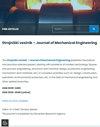通过测量AWJ直径确定聚焦喷嘴磨损
IF 1.2
4区 工程技术
Q3 ENGINEERING, MECHANICAL
Strojniski Vestnik-Journal of Mechanical Engineering
Pub Date : 2017-10-10
DOI:10.5545/SV-JME.2017.4424
引用次数: 3
摘要
磨料水射流(AWJ)切割是一种通用技术,但其精度相对较差。主要问题是射流的直径未知,因为市场上没有设备或仪器可以快速简便地测量它。有了这样的仪器,可以定期测量直径,监测喷嘴磨损和调整记录偏移量。这将大大提高过程的质量控制和切割的精度。本文研究了利用透束激光传感器监测射流直径和喷嘴磨损的方法。实验使用五种不同磨损的喷嘴,在两种不同的水压下,在不同的距离和不同的测量时间下,使用和不使用磨料进行了实验。结果表明,该仪器能够监测射流直径和喷嘴磨损,精度为±0.03 mm,但极易受到射流喷雾和磨料粘附在传感器屏幕上的影响。在不使用磨料、高水压和距离为1mm时,射流直径与聚焦喷嘴直径的相关性较好。本文章由计算机程序翻译,如有差异,请以英文原文为准。
Determining Focusing Nozzle Wear by Measuring AWJ Diameter
Abrasive water jet (AWJ) cutting is a versatile technology, but it is limited by relative poor accuracy. The main problem is the unknown diameter of the jet, as there is no device or instrument on the market that would enable a quick and easy measurement of it. With such an instrument the diameter could be regularly measured, nozzle wear monitored and noted offset adjusted. This would greatly improve the quality control of the process and the accuracy of the cut. This paper investigates the usage of a through-beam laser sensor for monitoring jet diameter and nozzle wear. Experiments were performed with five differently worn nozzles, with two different water pressures, with and without abrasive, at different standoff distances and with varying measuring times. Results show that the instrument is capable of monitoring the jet diameter and nozzle wear with an accuracy of ±0.03 mm, but it is very susceptible to the jet’s spray and abrasive sticking to the sensor’s screens. Jet diameter correlated better with the diameter of the focusing nozzle when taking measurements without the abrasive, at high water pressures and at a standoff distance of 1 mm.
求助全文
通过发布文献求助,成功后即可免费获取论文全文。
去求助
来源期刊
CiteScore
3.00
自引率
17.60%
发文量
56
审稿时长
4.1 months
期刊介绍:
The international journal publishes original and (mini)review articles covering the concepts of materials science, mechanics, kinematics, thermodynamics, energy and environment, mechatronics and robotics, fluid mechanics, tribology, cybernetics, industrial engineering and structural analysis.
The journal follows new trends and progress proven practice in the mechanical engineering and also in the closely related sciences as are electrical, civil and process engineering, medicine, microbiology, ecology, agriculture, transport systems, aviation, and others, thus creating a unique forum for interdisciplinary or multidisciplinary dialogue.

 求助内容:
求助内容: 应助结果提醒方式:
应助结果提醒方式:


